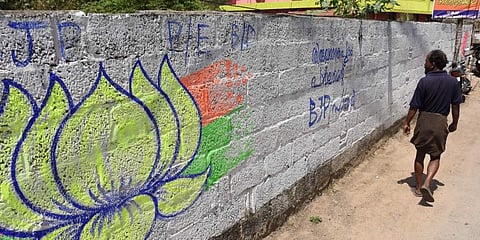

Election graffiti over the walls across the district is bringing back nostalgia to voters. The ban on vinyl flex by the election commission has brought back -a decade back- election memories. "Back then, elections were more like a festival of walls with graffiti, notices, posters and the announcements. With the ban on flex and green protocol, we hope to witness the lost election memories getting life in the upcoming Lok Sabha elections," says Graffiti artist Chamayam Pradeep.
Graffiti workers who had left the job or made the graffiti a part-time job had come back to the work. The artists have got huge demand due to reduced availability of the graffiti artist. "Usually we work during the night, but due to the increased targets and fewer artists, we work in the morning as well. We begin our work from 6 am and it will continue till 11 pm. Due to the risen temperature we take a break and resume to work from 3 pm and it will go till 11 pm," says Pradeep. He along with six of his teammates started to work for the Lok Sabha election graffiti on March 1. "We have covered nearly 425 walls in Vattiyoorkavu, Nemom and Thiruvananthapuram central," he added.
The ban had become a boon for the graffiti artist. Compared to yesteryears, artists have been getting good wages. "We get Rs 120 per metre of the wall. . Before the ban, we used to receive Rs 800 per 10-meter wall and now we are able to receive Rs 1, 200," says Pradeep. On a daily basis, the artist with the six-member team is able to get a total income of Rs 20,000 to 25,000.
According to the artists, GST had affected the cost of colour powders used for graffiti. "Initially the fluorescent colour powder had cost Rs 40 per 100 gram. Now, GST has reflected in the cost. The shops at Chalai charge Rs 60 to 80 per 100 gram," says artist Manoj Kumar from Mottamoodu.
Not every graffiti artist work for money. There is a lot of district-based artists who work out of affection for the party. According to graffiti artist Gopan Sagari, he is ready to work even without getting any wages. Reacting to the increased demand of graffiti artist he says, "The demand has increased, there are artists who receive Rs 2,000 per day. But I do not work for money. I'm ready to work for Rs 500 or for no wages at all out of the love for the party." Gopan has started the election graffiti works two weeks back this year and had covered more than 250 walls in the areas of Pettah, Vettucaud and Kattakada.
Sharing the nostalgia artist Suresh Babu from Kattakada says, "After the arrival of flex the demand for graffiti has reduced. Less than 15 walls were used for election graffiti per booth in the past elections. But now the same has increased to 25 and more with the flex ban."
Suresh, along with his team started the graffiti works on March 7. "We get a daily wage of Rs 1500 to 1700. It is less compared to the current market. But we give less importance to wages when it comes to elections and political party," says Suresh Babu. He has covered the areas of Kattakada, Malayinkeezhu, Ooruttambalam and Mannadikonam. "The ban on flex has helped us to get more works. Thought the demand of artist is more the availability of walls are less," opined Suresh.
